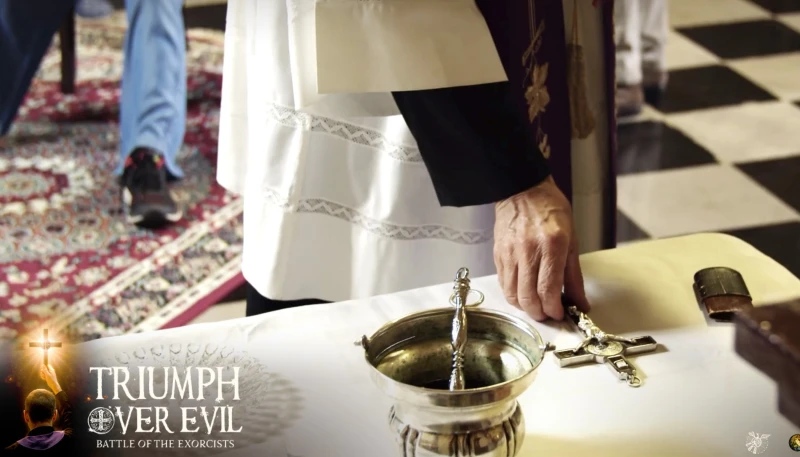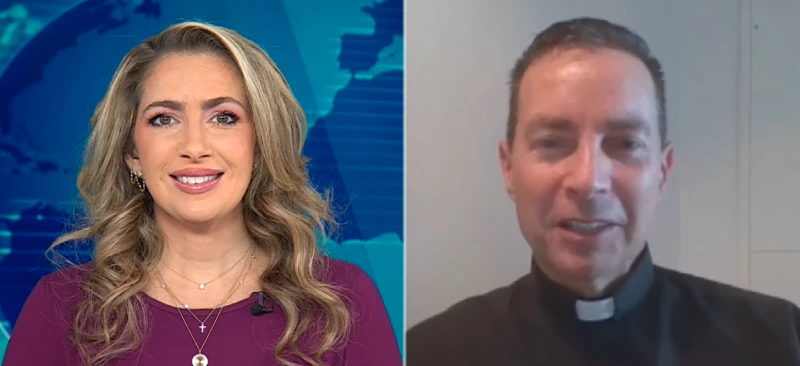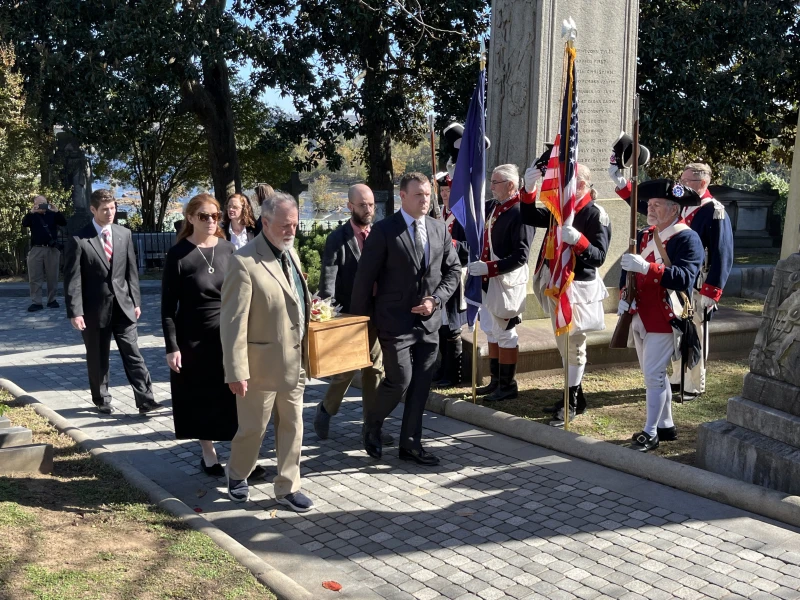 From left: Ross Douthat, media fellow at the Institute for Human Ecology; Will Wilson, CEO of AI company Antithesis; Father Michael Baggot, LC, professor of bioethics at the Pontifical Athenaeum Regina Apostolorum in Rome; and Brian J.A. Boyd, director for the Center for Ethics and Economic Justice at Loyola University New Orleans discuss AI and the Church on Sept. 23, 2025, at The Catholic University of America in Washington, D.C. / Credit: Tessa Gervasini/CNA
From left: Ross Douthat, media fellow at the Institute for Human Ecology; Will Wilson, CEO of AI company Antithesis; Father Michael Baggot, LC, professor of bioethics at the Pontifical Athenaeum Regina Apostolorum in Rome; and Brian J.A. Boyd, director for the Center for Ethics and Economic Justice at Loyola University New Orleans discuss AI and the Church on Sept. 23, 2025, at The Catholic University of America in Washington, D.C. / Credit: Tessa Gervasini/CNA
Washington, D.C., Sep 25, 2025 / 07:00 am (CNA).
The Catholic University of America (CUA) hosted a panel this week to discuss how Christians should think about the developing technology surrounding artificial intelligence (AI).
The Sept. 23 panel was hosted by CUA’s Institute for Human Ecology, which works to identify the economic, cultural, and social conditions vital for human flourishing. The group discussed the threats posed by AI, the future of the technology, and the Church’s place in the conversation.
Ross Douthat, media fellow at the Institute for Human Ecology, led the discussion between Father Michael Baggot, LC, professor of bioethics at the Pontifical Athenaeum Regina Apostolorum in Rome; Will Wilson, CEO of AI company Antithesis; and Brian J.A. Boyd, director for the Center for Ethics and Economic Justice at Loyola University New Orleans.
Douthat asked the panelists what they each believe to be the greatest threat of the emerging technology as it poses new challenges to the defense of human dignity, justice, and labor.
According to Boyd, the potential loss of human connection is the most prominent threat of AI. He said: “To be human is to be created in and for relationships of love — by love of God. Our nature is made to be receptive to grace.”
AI becomes an issue if “our main relationship and reference point is talking to a computer rather than to humans,” Boyd said. “I think that is an existential threat, and something worth discussing.”
“If we’re habituated to look at the screen before we look at our neighbor … and AI is [the] constant reference point, it will make habits of prayer much more difficult to include. It will make it harder to learn to listen to the voice of God, because the answer is always in your pocket.”
Baggot said his greatest concern is that “artificial intimacy is going to distract us from, and deter us from, the deep interpersonal bonds that are central to our happiness and our flourishing.”
“Companies now grip not only our minds but also are capturing our affections,” Baggot said. “We can all read about these tragic cases of exploitation and manipulation that are only going to continue unless we put proper guardrails in place and also provide the information that allows us to have the kind of deep interpersonal relationships we were made for.”
While many people worry that AI could create “mass unemployment,” Wilson said he disagrees: “I think that this is a very silly fear because human desires and human wants are infinite, and therefore, we always find new things for people to do.”
Rather, Wilson shared his concern that humans will no longer create their own ideas and will lose their intelligence and knowledge.
“The trouble with AI is even if it’s not actually intelligent, it does a very good simulacrum of intelligence, and it’s very tempting to use it to substitute for human intelligence,” Wilson said. “It’s very possible that we’re entering a world where very soon any cognitive labor, any reason, [or] any thought will be a luxury.”
Catholic AI
While there are dangers to AI, Baggot addressed the positive aspects the tool can offer, highlighting the benefits of Catholic AI companies.
“I’ve been privileged to work on the Scholarly Advisory Board of Magisterium AI, which is basically a Catholic answer engine that’s very narrowly trained on reliable documents, magisterial documents, [and] theological texts,” Baggot said.
Magisterium AI is a “system designed to give people reliable responses to their questions about the Catholic faith,” Baggot explained. “This is appealing to Catholics who want to go deeper, but it’s also quite appealing to people who have never really had the chance, or aren’t quite ready, to speak to another human person about their curiosities regarding Catholicism.”
Baggot explained that creators of the technology work hard to keep it from being “anthropomorphic” to avoid users confusing the AI with actual connection. He said: “We do not want people having an intimate relationship with it.”
While Magisterium AI can provide useful information, Baggot acknowledged that it is not a tool for spiritual direction. He said: “Spiritual direction … should be with another living, breathing human being who actually has insight into human experience [and] who can develop a relationship of real empathy and real compassion.”
The Church’s place in AI
The panelists had differing viewpoints about the Church’s place in AI and how Christians should approach it. Wilson said he believes “the conversation about where the technology is going and what we’re going to do with it is happening among people who do not care … what any Christian church has to say on the topic.”
“It’s actually a little hard to blame them because Christians have basically sacrificed their place at the forefront of science and technology, which is where we were in centuries past,” Wilson said.
“Control goes to those who can deploy the most capital, and capital gets allocated very fast to people who are able to deploy very efficiently. And by and large, those people are not Christians because Christians aren’t really trying.”
Baggot said that while AI does pose dangers, the Church “has a lot of insight and wisdom” that can help guide the conversation. “The Church is in a privileged position to leverage its incredible patrimony, its reflection on the human person, [and] human flourishing.”
“The Church has reflected a lot about the meaning and value of work, the subjective value of work. It’s not just about economic efficiency, but it’s about how I use my own God-given talents to grow as a person and then also to serve others in intrinsically valuable activities.”
Read More










![Judge rules against saints’ statues on Massachusetts government building #Catholic
Statues of St. Florian (at left) and St. Michael the Archangel (at right) are currently barred from appearing on the planned public safety building of Quincy, Massachusetts. / Credit: Courtesy of Office of Mayor Thomas Koch
Boston, Massachusetts, Oct 16, 2025 / 12:18 pm (CNA).
A Massachusetts trial court judge has issued an order blocking the installation of statues of two Catholic saints on a new public safety building in the city of Quincy, setting up a likely appeal that may determine how the state treats separation of church and state disputes going forward.The 10-foot-high bronze statues of St. Michael the Archangel and St. Florian, which were scheduled to be installed on the building’s façade this month, will instead await a higher court’s decision.The statues cost an estimated $850,000, part of the new, $175 million public safety building that will serve as police headquarters and administration offices for the Boston suburb’s fire department.Quincy Mayor Thomas Koch, a practicing Catholic, has said he chose St. Michael the Archangel because he is the patron of police officers and St. Florian because he is the patron of firefighters, not to send a message about religion.But the judge said the statues can’t be separated from the saints’ Catholic connections.“The complaint here plausibly alleges that the statues at issue convey a message endorsing one religion over others,” Norfolk County Superior Court Judge William Sullivan wrote in a 26-page ruling Oct. 14.The judge noted that the statues “represent two Catholic saints.”“The statues, particularly when considered together, patently endorse Catholic beliefs,” the judge wrote.The plaintiffs who brought the lawsuit challenging the statues — 15 city residents represented by the American Civil Liberties Union of Massachusetts — have amassed facts that “plausibly suggest that an objective observer would view these statues on the façade of the public safety building as primarily endorsing Catholicism/Christianity and conveying a distinctly religious message,” the judge wrote.Rachel Davidson, staff attorney at the ACLU of Massachusetts, who argued the case during a lengthy court hearing on Sept. 19, praised the judge’s decision.“This ruling affirms the bedrock principle that our government cannot favor one religion above others, or religious beliefs over nonreligious beliefs,” Davidson said in a written statement. “We are grateful to the court for acknowledging the immediate harm that the installation of these statues would cause and for ensuring that Quincy residents can continue to make their case for the proper separation of church and state, as the Massachusetts Constitution requires.”The mayor said the city will appeal.“We chose the statues of Michael and Florian to honor Quincy’s first responders, not to promote any religion,” Koch said in a written statement provided to the National Catholic Register, CNA’s sister news partner, by a spokesman. “These figures are recognized symbols of courage and sacrifice in police and fire communities across the world. We will appeal this ruling so our city can continue to celebrate and inspire the men and women who protect us.” The lawsuit, which was filed May 27 in Norfolk County Superior Court in Dedham, relies on the Massachusetts Constitution, not the U.S. Constitution, but there is a tie-in.In 1979, the Massachusetts Supreme Judicial Court adopted the U.S. Supreme Court’s 1971 three-pronged “Lemon test” when considering church and state cases — whether a law concerning religion has “a secular legislative purpose,” whether “its principal or primary effect … neither advances [n]or inhibits religion,” and whether it fosters “excessive entanglement between government and religion.” The state’s highest court also added a fourth standard — whether a “challenged practice” has “divisive political potential.”But in June 2022, the U.S. Supreme Court ditched the Lemon test in Kennedy v. Bremerton School District, a case involving prayers offered by a high school football coach in Washington state.If the Massachusetts Supreme Judicial Court, which is the ultimate interpreter of state law, takes the Quincy statues dispute, it would be the first time the court has considered a case on point since the U.S. Supreme Court’s Kennedy decision.This story was first published by the National Catholic Register, CNA’s sister news partner, and has been adapted by CNA.](https://unitedyam.com/wp-content/uploads/2025/10/judge-rules-against-saints-statues-on-massachusetts-government-building-catholic-statues-of-st-florian-at-left-and-st-michael-the-archangel-at-right-are-currently-barred-from-appea.webp)









